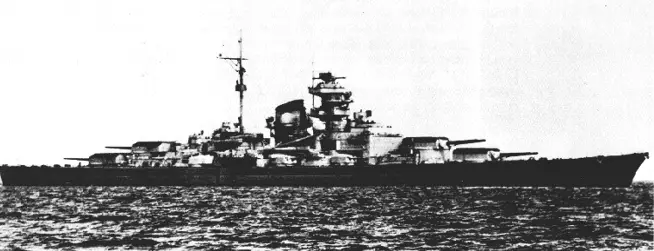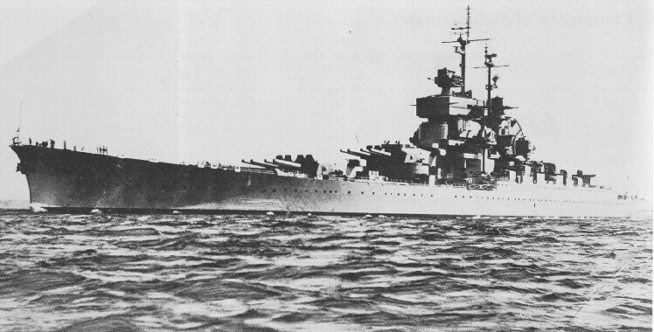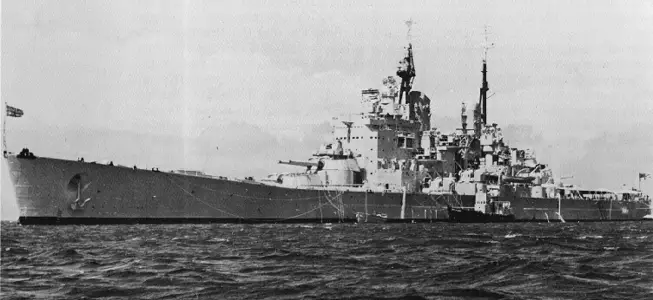|
The Post-Treaty Battleships (Part 1) By Chuck Hawks This essay proposes to compare the battleships designed and built by the major powers after the expiration of the Washington and London naval treaties. It will not be a "shoot out" per-se, although conclusions may be drawn from it. I propose to examine the fundamental characteristics of the following ships: Musashi (Jap.), Wisconsin (USA), Vanguard (UK), Tirpitz (Ger.), and Jean Bart (Fr.). These each represent the last of their class, and the last word in battleship design, as free from artificial constraints as possible. Of course, the design of all ships is determined by various constraints: size, tonnage, cost, harbor, dry dock, or canal facilities, and so forth. All were intended to fight World War II, although as it worked out, Vanguard missed the war by a few months, and Jean Bart missed it by years, becoming the last battleship ever completed. During the lives of these ships, certain technologies advanced at a terrific pace, driven by the pressure of war. The development of Radar (largely British) and the Atomic bomb (largely American) being, perhaps, the two most important. The allies, since they won the war, were the main beneficiaries of these technologies. Certainly, Wisconsin, Vanguard, and Jean Bart were equipped with radar (air search, sea search, and fire control) far beyond that available to Tirpitz or Musashi. Atomic shells were developed for Wisconsin's guns, and they could/may have been for Jean Bart and Vanguard (such matters are secret, but the technology certainly existed during their lifetimes). In the 1980's, the four Iowa class battleships were further updated with the latest guided missile technology, making them the most powerful surface combatants ever built, capable of destroying targets hundreds of miles distant. That is the real answer to the question of which was the most powerful battleship of them all: the American Iowa class. They lived to benefit from technology unknown to their contemporaries. Having said that, we are left with an empty feeling, a feeling that the answer begs the question. Therefore I propose to evaluate these battleships in terms of their fundamentals, leaving aside the advanced technologies from which the victors benefited (only in the case of Wisconsin will a partial exception be made, as she was reconstructed to face a different threat long after the passing of her contemporaries, and these interesting changes will be briefly addressed). After all, had Germany and Japan won the war, their ships would be the ones remembered for their advanced radar, nuclear weapons and so forth. These advances could have been incorporated into Musashi or Tirpitz, just as they were in the allied ships. I will look at such things as armament, protection, machinery and speed, range, sea keeping qualities, handling and maneuverability. These qualities I regard as central to the basic design. I will even go so far as to suggest which ship seems best in various ways. At the end, regardless of my opinion, you will have to decide for yourself which ship was the best overall; or, perhaps more important, best fulfilled her design requirements. Musashi and Wisconsin were designed for Pacific Ocean warfare. Tirpitz and Jean Bart were designed for use in the Atlantic ocean and Vanguard was designed with both Atlantic and Pacific operations in mind. Even within these Atlantic and Pacific groups, there are differences. Jean Bart's designers initially looked at the Italian fleet (especially the Littorio's) as likely adversaries and the Mediterranean, as well as the Atlantic, as potential scenes of conflict. Tirpitz's designers looked at combat in the North Atlantic against a numerically superior Royal Navy. Of the European ships, Vanguard was perhaps the most versatile. The North Atlantic was her home ground, but the Royal Navy had world wide commitments and it was envisioned that she would likely also serve in the Pacific. Even the Pacific power's battleships had somewhat different roles. Musashi was conceived as the ultimate weapon to defeat US battleships at sea in a climactic gun battle for naval supremacy. Wisconsin (BB 64),the last American battleship, was designed as a fast carrier escort. Her very high speed was an aircraft carrier, not a battleship, requirement; her superlative AA battery intended to protect the carriers she was escorting as much as herself. The cancelled Montana class would have been America's third generation version of the ultimate gunfighting battleship. When these facts are considered, it is perhaps understandable why the three Atlantic battleships are fairly similar in protection, speed, main battery and overall capability. Imagine them meeting one-on-one in some sort of tournament: it would be hard to predict the winner. The two Pacific battleships are different from the Atlantic trio, and from each other. They are hard to compare to each other. Each was probably superior for its designed role. Either out-gunned the Atlantic battleships. Tirpitz Let's start with the Atlantic battleships, and let's first examine Tirpitz. This famous ship is generally considered (at least by the Germans) as the finest expression of the European battleship. She provided the Germans with a "fleet in being" throughout most of the war. Stationed in Norway, news of her sailing sealed the fate of convoy PQ 17, even though she had returned to port before the slaughter began. She was the center of an enormous effort by the Royal Navy and the RAF to neutralize her. She was finally sunk at her berth near Tromso, by RAF heavy bombers using 12,000lb bombs, which no battleship could have resisted. Her basic specifications were as follows (from Conway's All the Worlds Fighting Ships): 
Tirpitz was reputed to be wet in a heavy sea, but a steady gun platform due to the stability conferred by her great beam, which also allowed excellent anti-torpedo protection. Her new pattern 15in guns fired a 1764lb shell to 38,720yds. She had a good AA battery. German rangefinders, and gunnery control in general, were highly regarded. Internal subdivision was extensive, a characteristic carried over from World War I German ship design. In fact, much of the Bismarck class design was based on the final German WW I battleship design, Baden. Because of this, Tirpitz exhibited some curiously old fashioned design features for a ship laid down in 1936 and completed in 1941. For instance, her 5.9in secondary armament were strictly anti-ship artillery. This required her to carry the 4.1in DP guns for heavy AA, an outmoded feature that wasted precious tonnage. More advanced contemporary battleships carried dual purpose secondary guns. The German 15in shells had a poor performance record and were inferior in sectional density compared to British and American AP shells. Of course, this had nothing to do with the design of the ship herself and presumably would have been rectified had Germany won the war. A more serious flaw was that her vital communications and fire control systems were routed above her main armored deck, leaving her vulnerable to becoming a "soft kill." This flaw sealed Bismarck's fate early in her final battle against British heavy units when her fire control system was knocked out, leaving her defenseless. Her steering gear compartments were vulnerable to damage, which led to Bismarck's being trapped by British heavy units in the first place. These flaws were more than theoretical, they led directly to the loss of Tirpitz's sister ship. In addition, German steam turbine machinery was questionable throughout the war. It tended to be too complex and unreliable. I feel that these flaws would, more likely than not, have put her at a disadvantage in a one-on-one shoot out against any of the other battleships examined here. Remember, though, that ship battles are as likely to be decided by some quirk of fate as by design. In any case, Tirpitz was a large, fast and powerful battleship. She and her sister ship, Bismarck, proved very difficult to sink. They may, in fact, have been pound for pound the hardest of all battleships to actually sink. Her design was, on the whole, a reasonable balance of protection, speed and armament. Jean Bart Jean Bart led an interesting career. Begun in 1939, she did not commence sea trials until 1949, or finally reach completion until 1952. When France fell in 1940, she escaped under her own power to North Africa. She was only about 77% complete at the time and mounted only one of her quadruple 15" turrets. In November of 1942, when the U.S. invaded North Africa, she tried to shoot it out with the new American 16in gun battleship Massachusetts. In this unequal battle she took 8-16in shell hits and was set ablaze. She was also torpedoed by US Navy aircraft. This damage was not repaired until after the war, when construction was resumed in 1946 at Brest. These are her particulars in the period 1952-1955 (from Conway's and The Encyclopedia of the World's Warships, by Hugh Lyon): 
As can be seen from these figures, this was a powerful battleship. She was generally superior to the Littorio's she was originally designed to face. Compared to Tirpitz, her speed, armor and underwater protection were superior, while her size and main battery were equivalent. Her 15in guns fired a 1938lb shell to 45,600yds at 35 degrees of elevation. As finally completed, she had a terrific AA battery. I have never heard any criticism of her sea keeping qualities, or maneuverability. However, her machinery was fuel inefficient. Like all other battleships, however, she was not perfect. She had a huge blind arc astern. Her quadruple main turrets (although internally divided) each housed 50% of her armament, bad news in that a single hit might knock out half of her main battery. In a battle between the two ships, I can easily imagine two 15in shell hits from Jean Bart knocking out two of Tirpitz's main turrets and 15in shell hits from Tripitz knocking out two of Jean Bart's main battery turrets. At that point, Tirpitz would still be firing four 15in guns and Jean Bart would be unable to return fire. Not a good situation for Jean Bart! In addition, her 6in secondary guns were not very good in the heavy AA role, requiring the fitting of the 3.9in mounts and wasting tonnage better used for other purposes. Her secondary guns were all clustered aft, leaving a huge blind arc foreword (the exact reverse situation of her main battery). The French realized the awkwardness of this layout and the fourth member of the class, Gascoigne, was redesigned with one 15in turret foreword and one aft, and with superfireing 6in turrets at both ends. The war intervened, and she was never laid down. Although less has been written about her than the other battleships considered here, Jean Bart was by all accounts a satisfactory ship. She was probably superior to her likely antagonists.Vanguard This brings us to Vanguard, the final chapter in the battleship history of the country that built more capital ships than anyone else. Vanguard was laid down in 1941, in the hope that she could be completed in time for service in World War II. This hope was based primarily on the fact that she was to use the existing 15in guns and turrets taken from the battlecruisers Courageous and Glorious when they were converted into aircraft carriers. The turrets were modernized by having their angle of elevation increased to 30 degrees and the armor on their faces and roofs was increased. The British 15in mounts had always been excellent, so the use of this old artillery did not put Vanguard at any great disadvantage compared to her European contemporaries. Indeed, her guns fired the British heavy 15in shells, which were markedly superior to the 15in shells of her Axis adversaries. Vanguard shared many of the good design features of the King George V class, as well as improvements to address their deficiencies. In appearance, Vanguard was perhaps the most attractive of all the modern battleships. Her graceful sheer foreword, twin funnels and symmetrical layout gave her an elegance and grace matched by few battleships In the event, the atom bombs ended the war before Vanguard could be finished and sent to the Far East. She was completed in 1946. Her basic specifications (again mostly from Conway's), were as follows: 
Vanguard proved to be a fine and well balanced ship. She had exceptional sea-keeping qualities and, while not as maneuverable as the Musashi or the Wisconsin, she handled well. Vanguard was reported to be a much better sea boat than the similar size American Iowa class ships, taking less water over her deck and rolling less in high seas. Her range was improved over that of the short-legged KG V's. Her very comprehensive protective scheme was similar to, but better than, the King George V class. Splinter protection was carried beyond the main belt, almost to the bow and stern of the ship. At the most favorable point, her torpedo protection was designed to withstand 1300lb of TNT. She was reported in Jane's Fighting Ships to have the most thorough damage control system ever installed in a British warship. Her 15in guns fired a new 1938lb 15in shell at 2458fps, good for a very satisfactory range of 33,550yds at 30 degree elevation. Her radar fire control was vastly superior to anything the Axis developed. The 5.25in secondary guns were in improved mounts, enhancing their DP utility. Vanguard's AA battery was excellent, exceeded only by some of the American third generation battleships. In a one-on-one shoot out with any of the axis battleships, I would expect her to defeat all of them, except the Japanese Yamato class. I feel Vanguard was a better all around ship than Jean Bart, with an obvious advantage in main and secondary battery layout. Vanguard was probably the finest of all the Allied battleships, with the possible exception of the American Iowa class. She had less firepower, speed and range than the Iowa's, but may have been a better balanced design. Her armor, underwater protection and general sea keeping qualities were superior to the Iowa's. Her sea speed was sufficient to allow her to accompany fast carrier task forces. About the only improvements I can suggest relate to the caliber of her main battery. On the same displacement she could have carried 9-16in guns (3x3), had they been available. The British, of course, knew this and had designed their Lion class battleships (the intended successors to the KGV's) for just this main battery. The extended development time of the new 16in mounts, coupled with the pressures of war, forced the cancellation of the Lions and the adoption of the existing 15in guns for the subsequent Vanguard. Vanguard seems to me to have been one of the best balanced battleships ever built. She was suitable for a wide range of conditions, with a near perfect blend of characteristics. She rates from very good to excellent in just about every category, admittedly without being the absolute top in any. I consider her to be the finest of the European battleships and my choice for the mythical "best all around" title. |